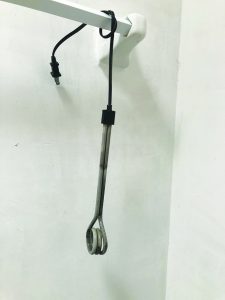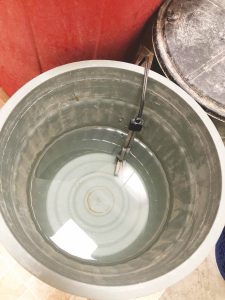My week out of the country left me grateful for even the silliest and least necessary of the US’s health and safety regulations which mean we can take beautiful, wonderful, blessed safety for granted.

In Mexico, where as I write this I’m staying with Sofia, a 37-year-old woman I’ve known for 30 years, and her 15-year-old daughter, it’s the opposite. Assume you could be killed at any moment, and take appropriate precautions.
It’s a tough life. For perspective, last night we had a simple restaurant meal for three, delivered. It cost 280 pesos – about $15, a day’s wage for common unskilled labor jobs such as what Sofia has in the factory of an American company.
Right now, as I write this it’s the next morning. I’m laying in the lower bunk bed with Sofia. She has bad diarrhea and nausea. My left eye is red and has been watering all morning. This might cancel our plans to go to the beauty shop today for fake fingernails and eyelashes, in preparation for a big party tomorrow.
We are playing with a tiny kitten her adult son found on the street. There are always stray cats and dogs everywhere.
I’m drinking instant coffee with sugar and milk out of a new ceramic mug, part of a dishes set I bought her yesterday. “Wow, Ama” (affectionate way to say “mama”), she said. “I’ve always loved dishes but never dreamt of having any.” Up until yesterday they ate off mismatched plastic discs.
My dangers on the way to this cup of coffee:
I washed my hands with the sink water, but brushed my teeth with bottled water. There is no current government warning that the tap water is so contaminated that it only should be used for flushing the toilet, but you still can’t drink it.

When I held the lighter to the stove’s burner to ignite the gas to heat the water, the flames exploded out onto my hand. Sofia and her daughter are used to that, but I’m not.
The pot used to heat water is a two-handled old casserole dish. There are no potholders – what a luxury expense that would be! – so I bunched up the old cut T-shirt which doubles as two dish towels to protect my hands from the heat of the handles.
It was stifling hot downstairs, so I attempted to open the front door to let in the morning air. I could not get it unlocked. The door has two deadbolt locks, and so does the heavy-duty screen door, which has metal security bars to keep out criminals. The key to the deadbolt goes all the way through the door – it’s twice as long as the keys we use in the U.S. I tried and tried and tried to get the lock open but could only budge the bolt partway.
Sure, Sofia or her daughter could jiggle it to open it – but – the naive American guest could not, a person with arthritis could not and neither could a short child. If there were a fire or other emergency, there would be no escape. There are two windows downstairs, but both are covered by security bars.
Just go out the back door, you say? Well luckily the other set of keys is right by the door (if the keys are lost, you’re trapped inside). However, the back patio (cement yard) is only about 10-by-6 feet and completely surrounded by 10-foot-high concrete block walls which keep out criminals who don’t have ladders. It also keeps us in.
That patio, incidentally, is used for laundry. Here a house commonly comes with a built-in cement sink with scrub board bottom for washing clothes, but Sofia has the luxury of a washing machine. It’s outside, so no telling how long it will last being exposed to rain. Laundry lines hang all around it.
During the course of my writing Sofia got up to take a bath. The bath situation scares me most of all: Put a heating coil of metal into a 5-gallon bucket of water then plug the heating coil’s electric cord into the outlet (there’s not even an off-on switch) and pull the plug out when the water is hot enough. And here in the US they’re always telling us not to put electric things in water!
Yes, she has a shower, but it’s not in use. The water pressure isn’t strong enough to bring water up there, but even if it was, she doesn’t have a hot water heater.

Sofia is grateful for her house. She grew up in an idyllic mountain village, the stuff of legends – got water from a spring in buckets carried on the head, no cars, no televisions or refrigerators- but also no jobs to be had and no way to feed your family unless you were a major landowner with enough farming space.
She came, wide-eyed and innocent – to a city of millions to earn a living. After 15 years of working, she was able to buy a newly constructed house, under a government program. It cost 427,000 pesos ($22,968), and 500 pesos ($26) are deducted from her paycheck each week to pay for it.
The cement townhouse is two stories, 10 feet wide by 25 feet long. The lower floor was just one long empty cement room with some electrical outlets in the walls and plumbing hookups for a sink. It has four circuit breakers in a breaker box with no cover, in the bathroom.
After she had lived here for about a year, she had installed some cement shelving and counter to form a kitchen area.
Well, my column is out of space without even having begun telling you how crazy dangerous it is outside with electrical hookups, traffic, water and sewage, etc.
So, I get out of bed, go downstairs, step up onto that cement block in front of the unusually high sink, and wash my coffee cup – careful not to splash water into the electrical outlet that is directly behind the faucet at counter level; if you don’t turn on or off the cold water carefully, your hand bumps the outlet.
Sofia announced that she’s feeling better, so we just may go fancy ourselves up at the beauty shop after all.





